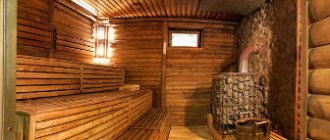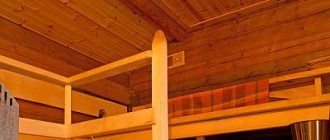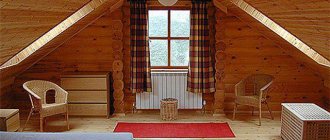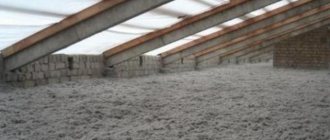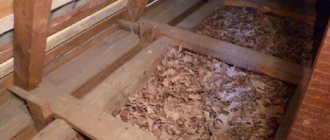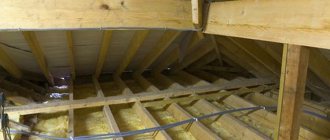Insulating a bathhouse with expanded clay is one of the methods for reducing heat loss during the operation of a bathhouse complex. The main heat leakage occurs from the bathhouse through the walls, floors and ceiling. The greatest contribution to heat loss comes from poorly insulated floors and ceilings.
To prevent heat losses, it is necessary to carry out work during the construction of the bathhouse to ensure high-quality thermal insulation of the premises of the bathhouse complex from the external environment.
For this purpose, you can use various materials that serve as good heat insulators. It can be:
- stone and mineral wool;
- ecowool;
- expanded polystyrene;
- expanded clay;
- wood sawdust.
One of the most popular materials used for insulation work is expanded clay, which is used most often in areas where there is a decrease in air temperature in winter below 350C.
Insulating the floor and ceiling in a bathhouse with expanded clay has a large number of advantages due to its properties.
The use of expanded clay to insulate the ceiling of a bathhouse, according to reviews from owners of suburban areas, makes it possible to carry out thermal insulation of the room efficiently and without large financial costs in order to prevent heat loss . In addition to heat-insulating properties, this expanded clay has excellent sound-proofing properties.
How to insulate the ceiling in a bathhouse with expanded clay
The ceiling in the bathhouse should hold heat well.
You can avoid heat loss from the attic by insulating it with expanded clay. It has been used as insulation for a long time, but has not lost its popularity. Expanded clay is a bulk building material made from clay by firing in special rotary kilns.
It is used not only as insulation, but also as a filler in the manufacture of lightweight concrete.
Thermal insulation qualities are due to its porous structure, which creates the effect of a thermos. Expanded clay is produced in different fractions: from sand (1.5–5 mm) to crushed stone 40 mm. The most popular granule size is 10–20 mm. This is what is most often used when insulating the ceiling.
Expanded clay has a number of positive properties:
- Resistant to cold. Withstands up to 25 cycles of freezing and complete defrosting.
- Not flammable.
- Biologically inactive.
- Easy to use.
- Light weight (1 m³ = 250 kg).
- Low thermal conductivity – 0.12–0.15 W/m².
- Low cost.
At the same time, it also has negative qualities:
- high amount of crumbs and dust;
- hygroscopicity.
Pile structures for the foundation
Often a bathhouse is built on piles, which represent a supporting structure and are used for installation under a log house. This is considered the simplest type of foundation. When insulating a bathhouse on stilts, there is one significant advantage - reliable waterproofing of the foundation itself by raising it above the ground. Most often, piles are represented by long metal pipes with blades that cut the soil.
After constructing the foundation on the piles, you need to lay a wooden covering, which itself will retain heat in the bathhouse. However, wooden flooring alone is not enough - it is necessary to make a base from a pipe that will connect all the screw piles, and then waterproof it with film.
Mineral wool tiles can be used as insulation between the film and the boards. External thermal insulation is carried out along the contour of the base using fasteners. After completion of the work, you can begin finishing the facade.
Carrying out work
Insulating the ceiling does not mean just pouring a layer of expanded clay. There are a number of nuances in this task that must be taken into account to obtain the desired result.
It should be remembered that insulation with expanded clay makes the structure heavier. Therefore, you will need to take care of the reliable fastening of the ceiling boards and, if necessary, strengthen them.
Before starting work, you need to prepare moisture and vapor barrier materials. The following options are valid:
- polyethylene film;
- roofing felt;
- aluminium foil.
Insulating a bathhouse begins with laying moisture-proofing materials. The simplest option is to apply clay coating to the ceiling boards. The thickness of such a vapor barrier should be 1.5–2 cm. The use of this insulation requires great physical effort and time. The coating takes at least 3 weeks to dry. Therefore, crumpled clay is used for the same purposes. Waterproofing is laid on the coating layer, the role of which is polyethylene film or roofing felt. The width of the material should be 10–15 cm greater than the distance between the floor beams. If the moisture barrier is laid overlapping, then the seams are glued with bitumen mastic or tape.
Expanded clay is poured between the beams, directly onto the prepared insulating material. Heat-saving properties are fully ensured when the insulation thickness is more than 10 cm. The recommended value is 14–16 cm. Expanded clay is poured into an even layer and leveled. For compaction purposes, material fractions of different sizes are used. Special attention is paid to the completeness of the backfill around the rafters, chimney and walls. The quality of laying the material directly affects heat loss. To prevent convection currents from occurring in the expanded clay layer, it is recommended to fill the insulating material with ordinary dry sand on top, having previously covered the expanded clay layer with agrofibre. It prevents sand from spilling out and does not create a “greenhouse effect.” Layer thickness – 3–5 cm.
Work on insulating the ceiling of a wooden house is almost no different from the technology described above. There is no need to install a vapor barrier here. Only waterproofing is used. If the house is two-story, then lighter materials are used for the ceiling of the first floor or it is not insulated at all.
Blitz tips
- To protect sawdust insulation from rodents, mold and bacteria and extend its service life, it is necessary to add 5-10% dry lime.
- After 1-2 years, dry sawdust shrinks and an additional small layer will be required.
- Due to the impediment of fresh sawdust to better bind cement with water, sawdust that has been sitting for more than 2-3 months should be used. For urgent construction, it is possible to add liquid glass.
- Smaller sawdust will require more water to wet the mixture. When using fresh chips, more cement composition is required, which affects the reduction in thermal insulation properties. It is advisable to purchase sawdust of the medium fraction, since fine sawdust involves dustier work, and coarse sawdust has worse thermal insulation properties. It is advisable that the waste undergoes pre-chamber drying, or the shavings should be placed under a canopy and lightly dried without covering them.
- The optimal choice is softwood sawdust due to its resin content, which helps repel bugs and rodents. When using material from deciduous trees, it must be mixed with antiseptic agents or ash.
- If there is debris in the sawdust, it should be selected manually or sifted through a sieve.
Checking completed work
After this, you need to ensure the quality of the insulation made. To do this, the bathhouse is heated and all sources of cold air (doors, ventilation, etc.) are closed. After warming up the room, the temperature is measured and the time is recorded. If it decreases quickly, then the insulation work was performed poorly. Then the reasons for the temperature drop are identified and eliminated. After this, the check is repeated. In a good sauna, the heat lasts up to 4 hours.
Periodically it is necessary to inspect the attic space for damage to the roof covering and moisture leaks. Such inspections are also necessary during heavy precipitation.
The ingress of water into the expanded clay layer significantly reduces its heat-saving qualities. Therefore, all leaks must be eliminated.
Insulating the ceiling alone will not solve the problems of maintaining heat in the room. Expanded clay is an almost ideal heat insulator, but only the integrated use of energy-saving technologies and materials will make your creation a truly Russian bathhouse.
Floor installation in the attic
In the case where the attic space is planned to be used as a habitable space or for household needs, then the work on insulating the ceiling in the house with expanded clay must be completed with a screed. In this case, it is not necessary to lay the top layer of vapor barrier. But before spreading the cement-sand mortar over the surface of the insulation, it is necessary to saturate the very top layer of expanded clay with cement laitance. This will make the solution easier to install.
If the screed serves as an independent coating, then after it has been leveled and dried, the work is considered complete. However, to equip an attic room using a dry screed, we install a finished floor. For this, you can use any materials: engineered wood, laminate, thick plywood or ceramic tiles.
Insulating the ceiling with expanded clay in a bathhouse is environmentally friendly and inexpensive
The bathhouse is a universal place for rest, relaxation and health improvement. It is known that the bath accelerates blood flow and stagnant processes in the body, promotes the rapid elimination of toxins and waste, rejuvenates the skin, and relieves fatigue. However, the entire effect depends on how well the bathhouse is designed.
The ceiling and walls of the bathhouse must be insulated. This is especially true for the ceiling, because it is under the ceiling that the temperature is highest, and when heated, the air becomes lighter and goes into the roof, into the attic and further into the street. As a result, all the energy and all the heat heat the space around the bathhouse, and this is wasteful. If the bathhouse ceiling is poorly insulated , condensation will appear on it. The appearance of condensation indicates that it is necessary to urgently begin the insulation process. It is best to carry out insulation at the construction stage of the bathhouse, because in this case you will not have to disassemble the structure.
Expanded clay is one of the many materials that is often used for insulation. It consists of fired porous clay granules. The unique thermal insulation properties of expanded clay are due to its cellular structure.
Technology
How to insulate a bathhouse ceiling with expanded clay? The technology for insulating the ceiling in a bathhouse with expanded clay is of medium complexity. In principle, anyone who does not have any construction skills can handle it. The insulation is installed from the attic side. First you need to put a layer of vapor barrier material. It will also perform the function of waterproofing.
The current construction market offers a huge variety of options for vapor barriers . These can be modern materials such as Izospan or analogues. You can take regular plastic film, roofing felt and aluminum foil. However, experts do not recommend roofing felt. When exposed to very high temperatures, it gets wet. In addition, roofing felt may catch fire.
The chimney pipe and rafter beams are also laid with a vapor barrier . The vapor barrier should be fixed higher than the height of the expanded clay layer. Vapor barrier film or membrane sheets are secured with a regular construction stapler or masking tape.
The expanded clay layer is not laid out immediately. First, lay a layer of crushed clay .
The expanded clay layer should be at least 12-15 cm. For better thermal insulation, material of two fractions is used, which are called expanded clay sand and expanded clay gravel. This will increase the density of the layer and reduce future subsidence of the granules.
And this article talks about how to make a fence from a chain-link mesh.
Installation of thermal insulation
Experts advise placing layers perpendicularly. This arrangement will increase the strength of the entire structure and help avoid severe deformation. If you use mineral wool and clay, the process will take place in several steps:
We invite you to familiarize yourself with a homemade iron stove for a bath, photo drawing
- take an unedged board (5 cm) and attach it to the bottom of the beams;
- to support the filing, we fix the flooring along all the bases;
- tongue and groove slats made of aspen are attached to them (taking into account the gap for ventilation);
- We lay vapor barrier material on the outside of the roof;
- spread mineral wool 15 cm wide over the laid mixture;
- then we lay polypropylene film;
- We place boards on top of the resulting structure; this is the future floor of the attic.
If everything is done correctly, the end result should be an excellent steam room. All the steam will remain inside for a long time, and the steam room will not cool down for a long time.
Advantages and disadvantages
Insulating a bathhouse ceiling with expanded clay has many more advantages than disadvantages. Let's name the main advantages of this material :
- environmental friendliness;
- over time, expanded clay does not decompose and does not release toxic substances;
- cheapness;
- excellent sound and heat insulation;
- fire resistance;
- Rodents, insects and fungi cannot live in expanded clay;
- the material is light in weight;
- expanded clay does not rot.
Expanded clay has virtually no disadvantages . Except that the insulation process will be a little labor-intensive for a beginner in construction.
And here is an article about insulating a bathhouse ceiling with foam plastic.
How to properly insulate a ceiling using expanded clay
The walls of the bathhouse, as well as its ceiling, must be insulated. This is especially true for the ceiling, since the ceiling is a high temperature zone. Heated air is always lighter than cool air, and because of this it rises, where it can go to the attic room and then move outside. Thus, thermal energy and heat heat the area around the bathhouse more, which is wasteful. An uninsulated bathhouse ceiling is a place for condensation to form. Its appearance signals that the process of insulating the bathhouse ceiling with expanded clay should begin as soon as possible. It is better to provide thermal insulation at the stage of building the bathhouse, then there will be no need for partial dismantling of the structure.
Types of expanded clay for insulation
Expanded clay, if used as a building material for insulation, has many advantages. According to its physical parameters, expanded clay is a porous and fairly lightweight building material that does not create large loads on the ceiling plane.
Externally, expanded clay looks like round granules. The raw material for the manufacture of heat insulators is clay, which is subjected to high-temperature firing. The use of natural raw materials in the production process guarantees the highest possible purity of the finished product.
Insulation can be found on the market in two varieties:
- expanded clay sand;
- expanded clay gravel.
Expanded clay sand is used in the form of aggregate in the preparation of mortars. The size of the main fraction included in this type of building material can vary in the range from 0.14 to 5 mm. This variety is used as a filler for mixtures and as backfill for ceiling insulation when forming a layer up to 50 mm thick.
Expanded clay gravel is a type of building material, the main fraction of which has a size ranging from 5 to 40 mm. This variety is used to insulate the floors, walls and ceilings of the premises of the bathhouse complex.
Laying technology
The principle of floor insulation with expanded clay is to arrange a heat-insulating layer into a prepared frame. First, a rigid base is prepared. If the material is poured directly onto the ground, it must be compacted well. Lay a row of waterproofing.
The next stage is the assembly of the frame, consisting of ordinary wide slats, reinforced with transverse bars.
In the case of a large insulation perimeter, it is recommended to divide the structure into several fragments.
The last thing is pouring the expanded clay mixture and fixing the fastening boards to the frame.
If the work is carried out under a screed, then the filled expanded clay is filled with a cement composition.
Recommendations
Attention should also be paid to floors that are fixed to pile foundations. Stages of work:
- Tie the pile heads together with special screw beams.
- Lay a layer of waterproofing on a wooden base made of beams.
- Place rough timbers on the lower sides of the beams.
- Lay sheets of thermal insulation and cover them with waterproofing film.
- Apply a finishing coat.
It is important not to confuse the method of laying the waterproofing film. Instructions are present on the packaging. Concrete floors in bath rooms need to be insulated
If this is not done, they will be very cold despite the heating of the rooms. For thermal insulation, you need to choose one of several types of materials. It is important to take into account the features of insulation when carrying out work independently
Concrete floors in bathhouses need to be insulated. If this is not done, they will be very cold despite the heating of the rooms. For thermal insulation you need to choose one of several types of materials
It is important to take into account the features of insulation when carrying out work independently
Advantages and disadvantages of expanded clay
When comparing expanded clay with other insulation materials, the following advantages of this insulation can be highlighted:
- Not biodegradable during use. Over time, most of the heat insulators used for thermal insulation of bathhouses undergo decomposition, which provokes the release of substances harmful to human health from their composition into the air. Expanded clay, despite its service life, does not emit harmful chemicals and does not deteriorate its thermal insulation characteristics.
- The insulation does not attract rodents, which allows it to be used for an almost unlimited time.
- Insulating the ceiling in a bathhouse using expanded clay guarantees high fire-resistant qualities of the ceiling, high sound insulation characteristics and increased resistance to water vapor.
- The insulation has high frost resistance. This building material can withstand up to 25 cycles of complete freezing followed by thawing without loss of thermal insulation properties.
In addition, expanded clay is characterized by low heat transfer rates, which range from 0.07 to 0.16 W/m, which makes it possible to use it as an effective insulation for a bathhouse.
Additionally, one more significant advantage of this building material should be noted - low cost, which contributes to the popularization of expanded clay as a thermal insulation material for bath complexes.
Baths made of expanded clay concrete blocks reviews
Reviews from owners about the construction of bathhouses made of expanded clay concrete blocks are not unanimous. There are pros and cons. Every owner dreams of getting not just a “box”, but a real masterpiece. Depending on the type of building (residential, industrial, warehouse), building materials are selected. If you are planning a bathhouse, expanded clay concrete is an excellent choice, but for a house, block structures are not the best alternative option.
- Oleg (Yaroslavl): I always dreamed of building a bathhouse on my site. When I approached the issue seriously, I was at a loss at the variety of alternatives on the construction market. A friend advised me to pay attention to expanded clay concrete blocks; according to him, they are not only affordable, but also high-quality building materials. This was my first independent construction. Despite various opinions about the material, I, like many other self-taught people, chose expanded clay concrete blocks for my bathhouse.
- Alex (Voronezh): My wife and I practically live at the dacha, the plot allows us to build a bathhouse, so we didn’t think twice about it, but began to develop a project and come up with a layout. When it came to choosing the material, and, of course, calculating the cost, I was confused. I started reading forums, consulted with professionals who build turnkey bathhouses and, despite numerous excuses, still decided to use expanded clay block. After all, I am the happy owner of a luxurious home bath.
- Vadim (Samara): My granddaughter is an athlete, so she needs regular baths. I am against public steam rooms, I prefer to have my own, but since my granddaughter needs it, I decided to build one. I calculated the cost, it’s not a cheap pleasure, but expanded clay concrete for building a bathhouse is not only a budget-friendly, but also a completely worthy alternative. When I talked about my idea at work, it turned out that there were more bathhouses built from expanded clay concrete blocks than I could have imagined. This gave me even more confidence and confidence in the right choice. We built a bathhouse with the whole family and don’t regret it, the reviews about the expanded clay block are only the most positive.
- Volodya (Krasnodar): My grandmother left me a plot; I’m not a gardener, so I won’t grow anything. Instead, I decided to slightly modernize my inheritance; there is a residential building there, and I decided to build a bathhouse so that I can often come and relax with friends. I chose blocks to build quickly. There were good reviews about foam blocks, but the cost did not please me, then I found out that a bathhouse made from expanded clay concrete blocks is no worse, and the price is much lower. My steam room is ready, I see only advantages for myself, I recommend it to everyone!
Despite negative reviews from builders and specialists about expanded clay concrete blocks, more and more self-taught people are using this material in home construction of baths. A small one-story house, a modest garage or a country bathhouse are the most popular objects made from budget building materials.
Generalization: advantages and disadvantages of expanded clay concrete baths. In what cases should you use expanded clay concrete block to build a bathhouse?
When choosing expanded clay block for a bathhouse, you should be prepared for its features. In addition, despite all the advantages, the material has its disadvantages.
Materials that should not be used when constructing a bath ceiling
Despite the indispensability of some materials used in the construction of a house, some of them can only harm a structure such as a bathhouse.
The list of undesirable materials for a bath ceiling usually includes the following:
- materials consisting of particle boards or plywood (fibreboard, chipboard). Moisture penetrating inside the plywood completely deforms it. In addition, these materials, when interacting with high temperature and humidity, begin to release substances harmful to human health;
- plastic. Despite the prevalence of this material in this type of installation, such as the exterior decoration of a house, it is categorically not recommended to use plastic for the ceiling of a bathhouse, since condensation will certainly protrude and accumulate on it;
- Styrofoam. This material, just like plywood, when interacting with hot and humid air, begins to release harmful substances.
The use of expanded clay in construction work
Expanded clay is used for the preparation of dry mixtures used in the insulation of foundations, walls and ceilings during the construction of various buildings, including buildings of bathhouse complexes.
Using a layer of expanded clay-based heat insulator, which has a thickness of 100 to 150 mm, can reduce heat loss by 70%. The insulation is ideal for filling hard-to-reach cavities in which it is impossible to install other heat-insulating building materials. It is capable of creating a very high-quality heat-insulating layer that will perform its functions for a long time and prevent heat loss.
In some cases, a mixture of expanded clay and polystyrene foam can be used to insulate the roof of a bathhouse. This mixture isolates the room from the external environment much more effectively than in the case of using mineral wool. A mixture of expanded clay and polystyrene can significantly reduce thermal energy losses and save on fuel consumption when heating the bath complex.
When purchasing building materials for insulation, it is necessary to take into account the degree of shrinkage, the coefficient of which is 1.15. 1 m3 contains about 20 bags of expanded clay. Possessing a high degree of fire resistance, this type of insulation does not change its stability when sudden temperature changes occur. Easily able to tolerate both severe frost and high temperatures. Very often the material is used as insulation in areas with harsh climatic conditions.
In order to properly insulate the bathhouse premises, care should be taken to insulate not only the ceiling, but also the floor of the premises.
A good effect from the use of expanded clay is felt when using a layer of insulation of at least 100 mm.
Tips for choosing insulation
The right choice of insulation is the key to success
The modern market offers a huge number of insulation materials. They differ from each other not only in their technical characteristics, but also in cost. However, you should not rely on the latter when choosing the best option.
The choice of insulation must be made based on:
- Type of flooring. Concrete floors are insulated with penoplex, expanded clay or perlite. The wooden floor is made of penoplex, as this is the only material that does not absorb moisture at all. It is undesirable to lay insulation with a fiber or open cellular structure under it, for example, expanded clay, since in this case it will be necessary to equip a reinforced layer of waterproofing. Penoplex can be replaced with foamed polymers - ecowool or Aisinin foam. Being light in weight, they retain heat well. However, electric, infrared or water heating can be installed under both concrete and wooden floors.
- The premises in which it will be installed. Organic insulation is suitable only for use in rest rooms or in the dressing room, since even treatment with fire retardants does not make them resistant to high temperatures.
- Personal wishes for safety - insulation can be organic and of plant or animal origin (felt, tow, cellulose) and inorganic (foam plastic, mineral wool and glass wool). The latter are produced through the processing of minerals and are characterized by resistance to high temperatures. However, they are inferior in environmental friendliness to organic insulation.
In addition, you need to pay attention to the specific gravity of the insulation itself. A good insulation is one that does not create additional load on the foundation

